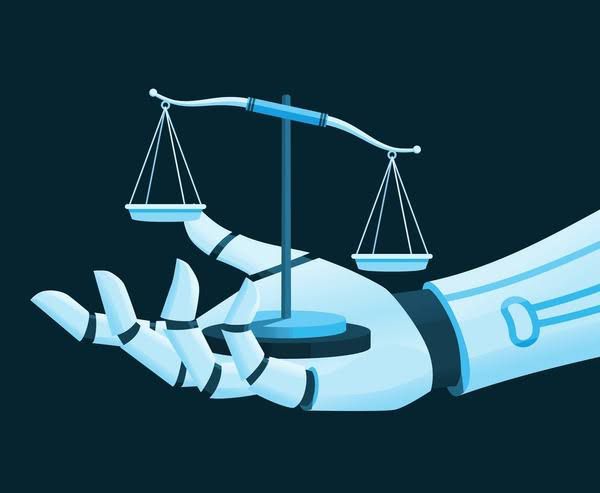Author: VAISHNAVI TRIPATHI, ARYA KANYA DEGREE COLLEGE, UNIVERSITY OF ALLAHABAD, PRAYAGRAJ
To the Point
The rapid proliferation of Artificial Intelligence (AI) technologies presents both unprecedented opportunities for societal advancement and profound challenges to fundamental human rights. While AI promises to revolutionize various sectors, from healthcare to justice, its pervasive nature and inherent characteristics – such as algorithmic opacity, data reliance, and autonomous decision-making – raise serious concerns regarding privacy, non-discrimination, freedom of expression, and due process. Striking a delicate balance between fostering innovation and safeguarding individual liberties is paramount for responsible AI governance. This article delves into the intricate interplay between AI and fundamental rights, examining the legal implications and proposing a way forward that prioritizes human-centric AI development and deployment.
Use of Legal Jargon
- Algorithmic Bias: Systematic and repeatable errors in an AI system’s output that create unfair or discriminatory outcomes.
- Data Protection: Legal frameworks and technical measures designed to protect personal data from unauthorized access, use, or disclosure.
- Right to Privacy: The fundamental right of individuals to be free from unwarranted intrusion into their personal lives, recognized under Article 21 of the Indian Constitution, as affirmed in K.S. Puttaswamy v. Union of India.
- Non-discrimination: The principle that individuals should not be treated unfavorably based on protected characteristics (e.g., race, religion, gender), enshrined in Article 14 of the Indian Constitution.
- Freedom of Expression: The right to express one’s opinions and ideas without fear of censorship or retaliation, guaranteed by Article 19(1)(a) of the Indian Constitution.
- Due Process: Means that the government must treat everyone fairly and follow the proper legal steps when making decisions that affect someone’s rights, especially in court or during legal proceedings.
- Accountability: Means being responsible for your actions. It means people or organizations must explain what they do, take ownership of their decisions, and be open and honest about the outcomes.
- Transparency: The principle of openness, communication, and accountability in the design, development, and deployment of AI systems.
The Proof
- Algorithmic Bias in Employment: AI-powered recruitment tools have been found to perpetuate existing gender and racial biases, leading to discriminatory hiring practices. For instance, Amazon reportedly scrapped an AI recruiting tool that showed bias against women.
- Predictive Policing and Discrimination: AI systems used in predictive policing can reinforce existing biases against certain communities, leading to over-policing and disproportionate arrests, thereby infringing on the right to equality.
- Facial Recognition and Surveillance: The growing use of facial recognition by police and private companies is raising serious concerns. People worry it could lead to constant monitoring, discourage public protests or gatherings, and even wrongly identify individuals — all of which can threaten our privacy and freedom of speech.
- Automated Decision-Making in Public Services: AI systems used in welfare distribution, loan applications, or criminal justice can make decisions with profound impacts on individuals’ lives without adequate transparency or avenues for redress, challenging due process and fairness.
- Deepfakes and Misinformation: Generative AI capabilities, particularly deepfakes, pose a threat to freedom of expression and the integrity of information, leading to the spread of misinformation and reputational harm.
- International bodies and national governments are actively addressing these concerns:
- UNESCO’s Recommendation on the Ethics of AI (2021): Endorsed by 193 countries, it provides a global framework for ethical AI, emphasizing human rights, fairness, and accountability.
- EU AI Act (enacted 2024, coming into full effect 2025): A landmark regulation that adopts a risk-based approach, imposing stricter rules on high-risk AI systems, including those used in critical infrastructure, law enforcement, and employment, with a strong focus on fundamental rights protection. It bans certain AI uses deemed to pose an unacceptable risk to fundamental rights.
- Digital Personal Data Protection Act, 2023 (India): While not specific to AI, this act provides a robust framework for data protection, which is crucial for mitigating AI-related privacy risks.
- Council of Europe Convention on AI, Human Rights, Democracy and the Rule of Law (CAI): This legally binding treaty aims to ensure that AI systems respect human rights, democracy, and the rule of law.
Abstract
This article explores the critical intersection of Artificial Intelligence (AI) and fundamental human rights, arguing for a balanced approach that fosters innovation while rigorously protecting individual liberties. It highlights how AI systems, due to their inherent characteristics like algorithmic bias and data reliance, can pose significant threats to privacy, non-discrimination, and freedom of expression. The article underscores the urgent need for robust legal and ethical frameworks, referencing international and national initiatives like the EU AI Act and India’s data protection laws. It concludes by advocating for human-centric AI development, emphasizing transparency, accountability, and meaningful human oversight to ensure AI serves as a tool for progress without undermining democratic values and constitutional safeguards.
Case Laws
While specific Indian Supreme Court judgments directly addressing AI are still emerging, existing jurisprudence on fundamental rights provides a crucial foundation:
- K.S. Puttaswamy v. Union of India (2017): This landmark judgment affirmed the Right to Privacy as a fundamental right under Article 21 of the Indian Constitution. This ruling is profoundly relevant to AI, given the vast amounts of personal data AI systems collect and process. Any AI application infringing on individual privacy would be subject to strict scrutiny under this precedent.
- Justice K.S. Puttaswamy (Retd.) v. Union of India (Aadhaar Judgment, 2018): While primarily concerning Aadhaar, this judgment further elaborated on the contours of the right to privacy and the need for proportionality in state actions involving personal data, principles directly applicable to AI governance. The court emphasized that any intrusion into privacy must be necessary, proportionate, and have a legitimate aim.
- Shreya Singhal v. Union of India (2015): This case, while primarily concerning Section 66A of the IT Act, affirmed the importance of freedom of speech and expression (Article 19(1)(a)). The principles articulated here are relevant to how AI might impact online speech, content moderation, and the spread of information and misinformation.
- Vishaka v. State of Rajasthan (1997) and Nalsa v. Union of India (2014): These cases, though not directly about AI, highlight the judiciary’s role in interpreting and expanding fundamental rights, particularly the right to equality (Article 14) and non-discrimination. The principles established in these judgments would be critical in challenging AI systems that exhibit or perpetuate discriminatory biases.
- State v. Loomis (Wisconsin Supreme Court, USA, 2016): This case involved the use of an algorithmic risk assessment tool (COMPAS) in sentencing. The court found that while the tool could be used, defendants must be fully informed about its limitations and have an opportunity to challenge its factual basis. This highlights concerns about transparency and due process in algorithmic decision-making within the justice system.
- European Court of Human Rights (ECtHR) cases on surveillance: While not AI-specific, judgments concerning state surveillance (e.g., Roman Zakharov v. Russia) emphasize the need for legal safeguards, necessity, and proportionality, which are directly transferable to AI-powered surveillance systems.
These judgments collectively emphasize that any technological advancement, including AI, must operate within the constitutional framework of fundamental rights, ensuring fairness, transparency, and accountability.
Conclusion
The rise of Artificial Intelligence presents a dual-edged sword: a powerful engine for innovation and a potential threat to fundamental rights. The inherent characteristics of AI systems, such as their complexity, data-intensive nature, and potential for autonomous operation, demand a proactive and rights-centric approach to governance. Unchecked AI development and deployment risk exacerbating existing societal inequalities, eroding privacy, curtailing freedom of expression, and undermining democratic principles.
To deal with these complicated issues, we need to take action on multiple fronts there’s no one-size-fits-all solution:
- Human-Centric AI Design: Prioritize ethical considerations and fundamental rights protection from the initial design phase of AI systems (privacy-by-design, fairness-by-design).
- Robust Legal and Regulatory Frameworks: Develop comprehensive legislation that addresses the specific challenges posed by AI, drawing lessons from international frameworks like the EU AI Act. This includes:
- Clear definitions of high-risk AI: Systems that pose significant risks to fundamental rights should be subject to stricter regulations, including mandatory human oversight, impact assessments, and transparency requirements.
- Provisions for algorithmic transparency and explainability: Users and affected individuals should have a right to understand how AI systems make decisions that impact them.
- Mechanisms for accountability and redress: Clear lines of responsibility must be established, and individuals must have effective avenues to challenge AI-driven decisions and seek remedies for harms caused.
- Strong data protection regimes: Enforce strict rules on data collection, processing, and retention, ensuring consent, purpose limitation, and data minimization.
- Independent Oversight and Auditing: Establish independent bodies capable of auditing AI systems for bias, accuracy, and compliance with human rights standards.
- Promoting AI Literacy and Public Dialogue: Foster public understanding of AI’s capabilities and limitations, and encourage broad societal engagement in shaping AI policy.
- International Cooperation: Collaborate globally to develop harmonized standards and best practices for responsible AI, recognizing the transnational nature of AI development and deployment.
- Judicial Preparedness: The judiciary must equip itself with the expertise to adjudicate complex AI-related cases, interpreting existing fundamental rights in the context of emerging technologies.
Ultimately, the goal is not to stifle AI innovation but to channel it towards a future where technology serves humanity without compromising the bedrock principles of liberty, equality, and justice. Striking this balance is not merely a legal imperative but a societal one, crucial for ensuring that AI remains a tool for progress and not a harbinger of unintended consequences.
FAQs
Q1: How does AI specifically threaten privacy rights?
Ans: AI systems often rely on vast amounts of personal data for training and operation. This can lead to privacy risks through extensive data collection without explicit consent, re-identification of anonymized data, unchecked surveillance (e.g., facial recognition), and data breaches.
Q2: What is algorithmic bias, and why is it a concern for fundamental rights?
Ans: Algorithmic bias refers to systematic and unfair discrimination produced by AI systems. It arises when training data reflects societal biases or when algorithms are designed or implemented poorly. This is a concern for fundamental rights because it can lead to discriminatory outcomes in areas like employment, credit scoring, criminal justice, and access to public services, violating the right to equality and non-discrimination.
Q3: Can AI impact freedom of expression? If so, how?
Ans: Yes, AI can impact freedom of expression in several ways. AI-powered content moderation systems can err by over-censoring legitimate speech or failing to remove harmful content. Generative AI can create “deepfakes” and spread misinformation, undermining trust in information. Furthermore, AI-driven personalization algorithms can create “filter bubbles,” limiting exposure to diverse viewpoints.
Q4: What role does accountability play in regulating AI?
Ans: Accountability is crucial because it ensures that there are clear lines of responsibility for the actions and impacts of AI systems. When an AI system causes harm or makes an unfair decision, it’s essential to identify who is responsible (developers, deployers, users) and provide mechanisms for affected individuals to seek redress. This prevents a “responsibility gap” in the face of autonomous AI.
Q5: What is the “risk-based approach” to AI regulation, as seen in the EU AI Act?
Ans: The risk-based approach categorizes AI systems based on the level of risk they pose to fundamental rights and safety. Systems deemed “unacceptable risk” (e.g., social scoring by governments) are generally banned. “High-risk” systems (e.g., in critical infrastructure, law enforcement, employment) face stringent requirements, including human oversight, data governance, transparency, and conformity assessments. Other AI systems are subject to lighter regulations or voluntary codes of conduct.




